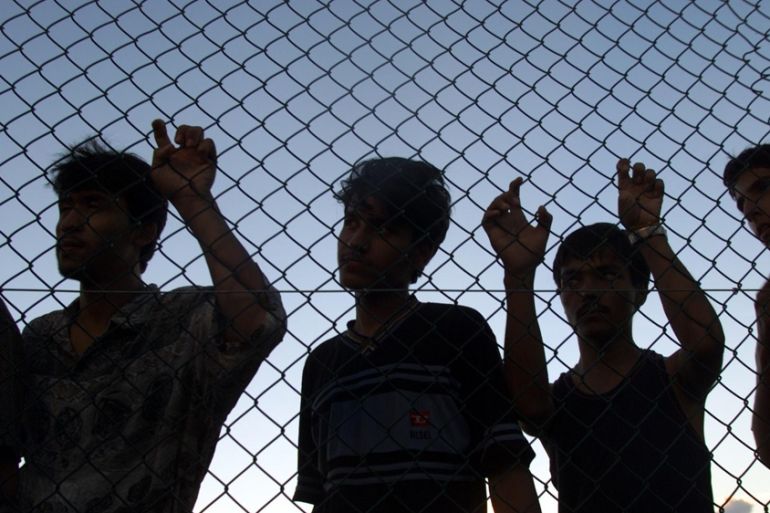Trump’s extremist border policies are part of a global authoritarian moment
Successive government in the US, the UK and Australia have embraced and exchanged brutal migration policies for years.
Published On 19 Feb 202519 Feb 2025
On January 29, United States President Donald Trump signed an executive memorandum instructing his government to expand detention capacity at Guantánamo Bay’s Migrant Operations Center. Speaking before the signing, Trump claimed the proposed 30,000 beds were necessary for “eradicating the scourge of migrant crime” and would hold “the worst criminal illegal aliens threatening the American people” whom the US did not “trust” would not seek to return if deported.
This came amid an onslaught of anti-migrant executive orders, including the Laken Riley Act, requiring the Department of Homeland Security to detain non-US nationals arrested, but not necessarily found guilty, for burglary, theft, larceny or shoplifting, thereby denying many migrants access to due process.
As extreme as these policies are, and even as they seem indicative of a present authoritarian moment, they are not unique to Trump nor to the US. Nor are they without historical precedent.
For decades, the US, the United Kingdom, and Australia have been experimenting with offshore detention abroad and increasing criminalisation of migrants at home. Tracing how these policies have evolved together, circulated across all three countries, coming in and out of favour, reveals how the roots of this current authoritarian moment in world politics go deeper than any one state, party, or political perspective. Rather, their roots lie in racialised carceral violence that gets continuously recycled and amplified through nation-state borders.
AdvertisementThe US experiment with offshore detention began in the 1980s, with the opening of a detention centre in Fort Allen, Puerto Rico, and the introduction of “interdiction” policies which sought to intercept and return predominantly Haitian asylum seekers at sea to prevent them from reaching the US. In the 1990s, these policies were expanded with the naval base situated on Guantánamo Bay, used to detain 36,000 Haitian and 20,000 Cuban people seeking asylum between 1991 and 1996.
Shortly after, in 2001, the Australian government introduced the so-called Pacific Solution, which saw Nauru and Manus Island in Papua New Guinea incorporated into an elaborate architecture of offshore detention. These centres became marred by reports of human rights violations and extensive evidence of abuse and cruelty, yet the Pacific Solution persists to this day and was seen as a model to emulate by British governments.
The previous Conservative cabinet drew directly from Australia’s offshore policy to design a plan to deport people seeking asylum to Rwanda. Although the plan was shelved when Keir Starmer’s Labour Party came to power in 2024, he too has looked to Italy’s offshoring in Albania as a possible model to emulate.
In all these countries, the offshore infrastructure and related deterrent logic persist even when political vicissitudes dictate a shift away from incarcerating people offshore. Thus, in Australia, when the first iteration of the Pacific Solution was terminated in 2007, the physical spaces and legal framework of offshoring remained intact, allowing for this policy to be easily reinvigorated and hardened with the Pacific Solution 2.0 in 2012.
AdvertisementWhen the Australian government moved the last person out of the Nauru detention centre in 2023, they never terminated their corporate contracts, allowing the centre to be repopulated with people seeking asylum only months later.
One of the major effects of offshore detention is to exclude detainees territorially and therefore legally from ordinary rights and protections, as well as to isolate them from the support of community and advocacy networks. This is mirrored domestically by the growing criminalisation of migrants.
By creating new migration-related crimes, mandating the detention and deportation of noncitizens with criminal convictions, and removing avenues for appeal or representation, states have constructed an increasingly illegalised population without rights. At the same time, they have elided migration and criminality in public debate.
This sets the scene for politicians to compete with one another by offering deterrence through ever-expanding detention as the only possible solution, especially during election campaigns.
The US example of the 1996 Illegal Immigration Reform and Immigrant Responsibility Act shows this clearly. Passed in the run-up to a presidential election, IIRIRA expanded the definition of “aggravated felon” and the scope of deportable noncitizens (including retroactively). The Act established close cooperation between immigration enforcement and local police, massively increasing detention and deportation figures and the militarisation of the US-Mexico border.
AdvertisementToday, Trump’s executive orders, and claims of defending against an “invasion” by “criminal illegal aliens”, are an intensification of this existing system and its racialised logics of deterrence.
Like a carceral boomerang, this system of criminalising and incarcerating people who are seeking dignified life ricochets between its onshore and offshore incarnations within countries, as well as between countries. This criminalisation intensifies during election cycles, when borders become spectacles of political strength, with parties across political divides using tough on migration narratives to evidence their ability to govern the nation and to distract from failures in health services, housing, welfare, employment and more.
The past 12 months have been no exception, with elections in the UK and the US and now an impending election in Australia. Each of these elections has pivoted around a gross expansion of policy proposals for offshoring detention, the deportation of large swaths of people, and the undermining, if not death, of our international protection regime.
As the politicisation of migration continues, the goalposts of what is deemed acceptable move ever towards the right, leading to policies that offer greater restrictions on rights and promise more harms.
This spectacle of cruelty also distracts from another failure – the very failure of these restrictive policies and the profound absence of political leadership on migration. What research shows again and again is how these policies do not deter people from arriving, but instead further harm people already marginalised in our societies.
AdvertisementHarm and abandonment are fundamental to the international systems of immigration detention, not accidental by-products produced by a lack of monitoring or rogue individuals or corporations. Harm and abandonment are “by design”. They are necessary features of coercive detention and deportation systems fuelled by political and financial profits built on this harm.
Yet, the violences and injustices of detention are constantly resisted. Around the world, protests, strikes, riots, and jailbreaks by detained people have been met with solidarity by civil rights campaigners, grassroots activists, faith groups, community organisers, lawyers, families and friends.
Conditions, abuses, judgements, and laws have been challenged, raids resisted, bonds posted, sanctuary policies passed, border enforcement agencies defunded, and local networks built to shut down detention sites and support people at risk of detention.
This resistance and solidarity was demonstrated in a 23-day protest led by men incarcerated in the Manus Island detention centre, following the announcement of its closure in 2017, when Papua New Guinea ruled it unconstitutional. Despite intimidation by security forces intensifying and their access to food, water, and electricity being cut off, the men peacefully fought for freedom in place of re-incarceration in new sites, drawing on their ties to local Manusian communities and Australian advocates, while communicating their plight to an international audience.
The documented treatment of those held in offshore sites speaks to an authoritarianism in migration governance, one which promises to affect citizens and noncitizens alike. As Behrouz Boochani, poet, journalist, and former prisoner of Australia’s immigration detention centre in Manus, describes in his book Freedom, Only Freedom: “The refugees have identified and exposed the face of an emerging twenty-first-century dictatorship and fascism, a dictatorship and fascism that will one day creep into Australian society and into people’s homes like a cancer.”
AdvertisementIn the US, as elsewhere, grassroots coalitions between people with lived experience of detention and abolitionist organisers built over decades of struggle formed the basis of resistance under Trump 1.0, and they will do so again. For it is those bearing the brunt of the carceral state’s attacks – and not the corporate liberalism of mainstream “left-wing” parties – that pose the strongest opposition and alternative to our present authoritarian moment.
The views expressed in this article are the author’s own and do not necessarily reflect Al Jazeera’s editorial stance.
